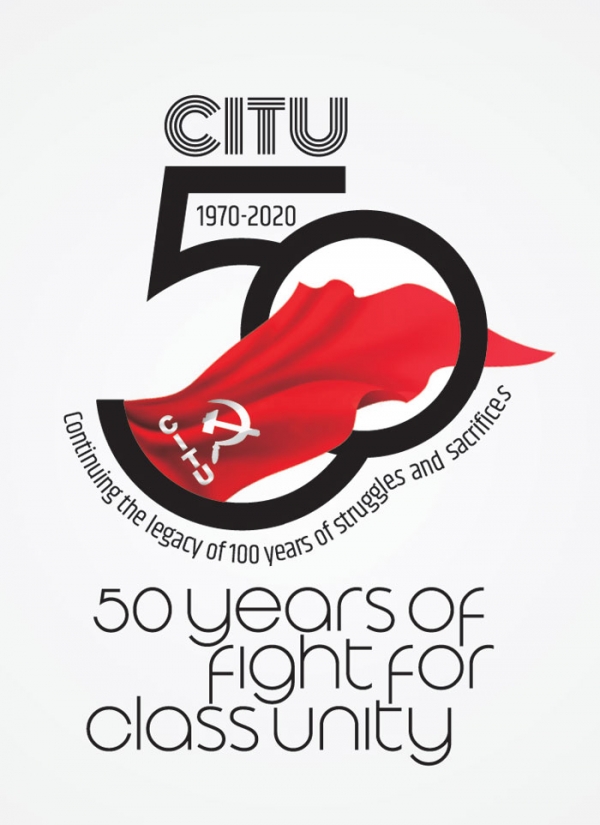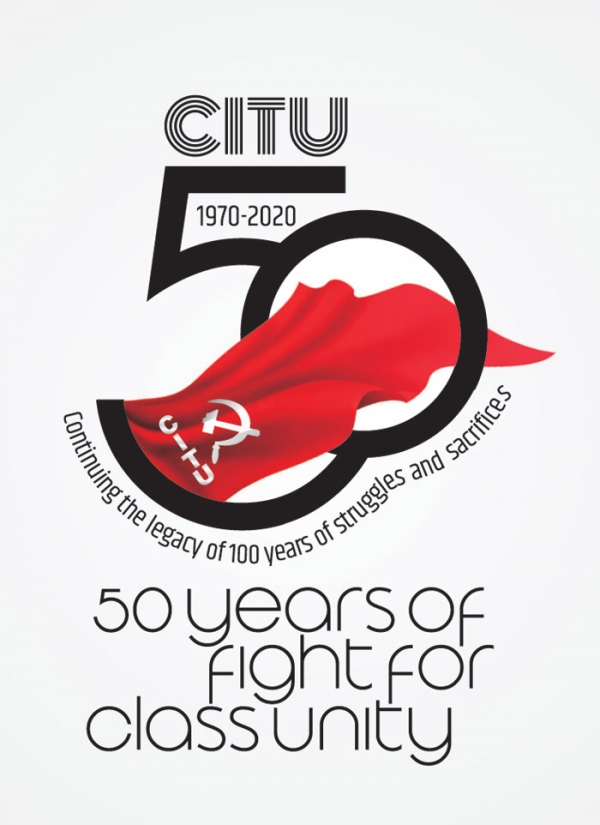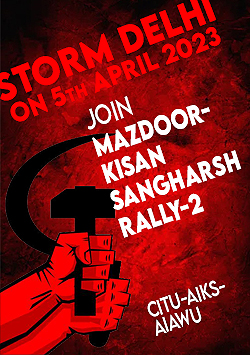
CITU_50 (2)
'100 years of Struggles and Sacrifices’ of the Working Class of India
Written by Super UserBEGINNING on 30 May 2019, CITU is going for a year long celebration of “100 years of struggles and sacrifices” of the working class of India, since the formation of the First Trade Union Centre, and “50 years of fight for unity of the working class” since the formation of the Centre of Indian Trade Unions.
Following are historical milestones of these working class struggles and sacrifices, till the formation of CITU, for the class and people’s cause, class unity, and developing class perspective and orientation. From the lessons of these struggles emerged CITU’s clarion call of “Unity and Struggle”. How, as the legacy of these working class struggles and sacrifices, CITU carried these forward and created historical milestones are dealt with separately.
I
EMERGENCE of the first Trade Union Centre in India has its own background of working class struggles and sacrifices. Class struggle is inherent in the very nature of the capitalist mode of production, remaining dormant among the working class, sometimes spontaneously bursting out in the given situation. The trade union organises, builds movements and leads them in an objective direction.
- There were several strikes and agitations in the last quarter of the nineteenth and more than one and a half of the first decades of twentieth century. Those were led by workers agitationist groups, welfare centres and mass of workers as trade unions led by individuals and philanthropists. These unions had no regular membership, constitution, organizational set up etc like those of the modern trade unions.
- But this period was also marked by the political consciousness of the Indian working class, developed along with the freedom struggle. In July 1908, when Lokmanya Bal Gangadhar Tilak was convicted and sentenced to six years’ imprisonment on charges of ‘sedition’, “Bombay was shut down in protest,…workers of all textile mills and railway workshops went on strike, army was called out,…16 workers lay dead in the streets with nearly 50 others seriously injured,” wrote historian Bipan Chandra in India’s Struggle for Independence.
On this, BTR writes (The Marxist, October-December 1985), “The workers were being drawn into the national protest against British tyranny. This happened in 1908 when Lokmanya Tilak was sentenced to six years’ imprisonment. The workers went on a one-day strike for every year of the sentence. They clashed with the police and the British army. Several were killed. Their resistance galvanised the entire city of Bombay and drew into action small businessmen and the middle classes. This was the first time that the working class used the powerful weapon strike in all industries for a political purpose and revealed its efficacy as the general mobiliser of the people.”
Class Unity - Class Struggle: Class Struggle to End Exploitation For Social Transformation
Written by Super UserIt was with this vision that Centre of Indian Trade Unions (CITU) was founded in 1970. The yearlong Golden Jubilee celebrations of CITU will start on its Foundation Day this year, on 30th May.
This vision was clearly spelt out in the Constitution of CITU thus: ‘The CITU believes that the exploitation of the working class can be ended only by socialising all means of production, distribution and exchange and establishing a Socialist State. Holding fast the ideals of socialism, the CITU stands for the complete emancipation of the society from all exploitation’.
Further, ‘It firmly adheres to the position that no transformation can be brought about without class struggle and shall constantly repel attempts to take the working class along the path of class collaboration’.
This vision stood the test of time. Fifty years of experience has further strengthened CITU’s determination to carry forward this vision to achieve its Constitutional objectives.
CITU was born at a time when the working class of the country was simmering with discontent and anger at the growing attacks on their working and living conditions. Closures, job losses, increasing contractorisation, denial of collective bargaining rights, social security benefits etc resulted in outbursts of struggles and strikes in different sectors in different parts of the country. Jute workers, coal workers, steel workers, textile workers, transport workers and hundreds of thousands of workers in various other industries, were all on the struggle path.
The need of the hour was to unite all the workers in each sector, to unite all the workers in all sectors into a common united struggle against these attacks, against the policies of the then government, against the exploitative policy regime. The need of the hour was to unite the entire trade union movement to build a powerful class struggle against these attacks as well as the policies.
But the then leadership of the dominant Left trade union, AITUC chose, not the path of class struggle but the path of class collaboration in the name of the ‘two pillar policy’. The very idea of class struggle was sought to be ridiculed. The section of leadership within the AITUC that favoured class unity and class struggle was harassed, victimised and undemocratically and unceremoniously removed from leadership positions, from the unions. The unions that supported class struggle were denied affiliation; their affiliations were cancelled.
After all the efforts through a period of around ten years to steer the organisation away from the path of class collaboration and compromise with the ruling classes failed, the need to form a new trade union centre to bring the trade union movement of the country into the track of united struggles against the government policies was strongly felt. CITU was born with the thunderous slogan ‘Unity and Struggle’.
BT Ranadive was elected the first president and P Ramamurty, the first general secretary.
Soon after its formation, CITU, through its actions gave a befitting reply to all those who sought to isolate it and ridiculed its slogan of ‘unity’.
¨ Soon after CITU’s formation, in an attempt to isolate it, the National Council of Trade Unions (NCTU) was formed with INTUC, AITUC and HMS at the initiative the then Union Labour Minister, to support government policies. CITU effectively countered it by bringing the other trade union centres and industrial federation together to form the United Council of Trade Unions (UCTU) to fight against the government policies like wage freeze, compulsory deposit scheme etc
¨ The isolationist strategy of the ruling classes through could not be sustained for long in the face of vigorous efforts by CITU to unite the other forces both in industries and services to carry on united struggles. Within three years NCTU collapsed. New correlation started developing within the country’s trade union movement through CITU’s consistent fight against class collaborationist policies.




